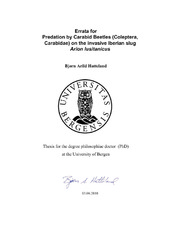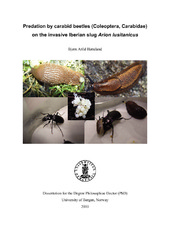| dc.contributor.author | Hatteland, Bjørn Arild | eng |
| dc.date.accessioned | 2011-01-20T14:08:35Z | |
| dc.date.available | 2011-01-20T14:08:35Z | |
| dc.date.issued | 2010-06-21 | eng |
| dc.identifier.isbn | 978-82-308-1556-4 (print version) | en_US |
| dc.identifier.uri | http://hdl.handle.net/1956/4447 | |
| dc.description.abstract | Predator-prey and host-parasite interactions are essential in understanding the population dynamics of any species, including pest species. In fact, integrated pest management that incorporates biological control requires a thorough understanding of the ecology of the pest and their interactions with natural enemies. The Iberian slug Arion lusitanicus has been spread from southern Europe to many parts of northern Europe, and has become a pest species in gardens, horticulture and agriculture. One of the explanations or hypotheses for the success of this introduced species has been that it lacks natural enemies. In the present study this hypothesis was tested by investigating selected predatory beetles that are known to feed on gastropods; four carabid beetles and one staphylinid beetle. However, in order to differentiate A. lusitanicus in Norway from the closely related native species, such as A. ater and potential hybrids, its taxonomic status had first to be resolved. A combination of morphological and DNA-based methods were applied, which revealed that A. lusitanicus in Norway is a pest form, which is clearly separated from A. ater based on morphological characters. However, the mitochondrial DNA of some A. ater showed A. lusitanicus haplotypes, suggesting there may have been introgression. Further, many of the A. ater specimens tested showed clear hybridisation with A. rufus confirming the complexity of the large arionids. Using those taxonomic/systematic characters which reliably differentiate these species a diagnostic DNAbased method employing a multiplex PCR was developed. This was optimized further to allow detection of slug-DNA in predators such as carabid beetles. The abilities of the predatory beetles to kill and feed on eggs of A. lusitanicus as well as newly hatched slugs and juveniles were tested in the laboratory, where the carabids Pterostichus niger, P. melanarius, Carabus nemoralis and the staphylinid Staphylinus erythropterus all fed on eggs and newly hatched slugs, while the carabid Nebria brevicollis hardly consumed any eggs or slugs. In addition, C. nemoralis was able to consume juvenile slugs up to one gram fresh weight. This carabid beetle is very common and active in spring in northern Europe when A. lusitanicus is highly abundant as juveniles, and predation was found to be significant in meadows and strawberry patches until the slugs grew larger (2-10g fresh weight) in the beginning of summer. Furthermore, C. nemoralis showed no preference for any specific slug species either in the laboratory testing D. reticulatum versus A. lusitanicus, nor in the field as long as the slugs were less than one gram. Instead C. nemoralis switched to the most abundant prey, which in most cases was A. lusitanicus. Thus, this beetle seems to be an opportunistic slug predator feeding on the most abundant slug species present at a given time. The nematode Phasmarhabditis hermaphrodita containing the bacteria symbiont Moraxella osloensis is being used as a biological control agent against slugs including A. lusitanicus, but the effect in the field is often short-lasting. Intraguild predation has been proposed as being part of the explanation for this, where predators may feed directly on nematodes or indirectly by consuming infected slugs. Hence a field experiment testing this latter part of the explanation was carried out. The non-pest slug Arion silvaticus and D. reticulatum were strongly affected by the applied nematodes, while A. lusitanicus was only moderately affected. Intraguild predation on nematode-infected slugs was low in the field compared to predation on uninfected slugs as indicated by 22% of the beetles being positive for slug-DNA while only 2% were positive for nematode-DNA. Thus carabid beetles are probably not a significant reason why the nematodes disappear from the field shortly after application. Carabus nemoralis may be used in conservation biological control of A. lusitanicus by facilitating set-asides and the cropped field for sustaining this species and other carabids in the area. Future studies should focus on manipulation experiments to find what densities of beetles are required to achieve a significant impact on slug populations, and how practicable this might be in commercial agriculture. | en_US |
| dc.language.iso | eng | eng |
| dc.publisher | The University of Bergen | en_US |
| dc.relation.haspart | Paper 1: Hatteland, B. A.; Noble, L. R.; Schander, C.; Skage, M.; Solhøy, T., 2010, Differentiation of the invasive Arion lusitanicus and the native Arion ater (Pulmonata, Arionidae) in Norway using morphology and genetics. Full text not available in BORA. | en_US |
| dc.relation.haspart | Paper 2: Bulletin of Entomological Research 100(5), Hatteland, B. A.; Grutle, K.; Mong, C. E.; Skartveit, J.; Symondson, W. O. C.; Solhøy, T., Predation by beetles (Carabidae, Staphylinidae) on eggs and juveniles of the Iberian slug Arion lusitanicus in the laboratory, pp. 559-567. Full-text available in BORA: <a href="http://hdl.handle.net/1956/5059" target="_blank">http://hdl.handle.net/1956/5059</a> | en_US |
| dc.relation.haspart | Paper 3: Hatteland, B. A.; King, R. A.; Symondson, W. O. C.; Solhøy, T., 2010, Molecular analysis of predation by carabid beetles (Carabidae) on the invasive Iberian slug Arion lusitanicus. Full text not available in BORA. | en_US |
| dc.relation.haspart | Paper 4: Hatteland, B. A.; Haukeland, S.; Roth, S.; Brurberg, M. B.; Symondson, W. O. C., 2010, Spatiotemporal dynamics of predation by carabid beetles (Carabidae) on nematode infected and uninfected slugs in the field. Full text not available in BORA. | en_US |
| dc.subject | Arionidae | eng |
| dc.subject | Carabus nemoralis | eng |
| dc.subject | Deroceras reticulatum | eng |
| dc.subject | Molecular methods | eng |
| dc.subject | Predator-prey interactions | eng |
| dc.title | Predation by carabid beetles (Coleoptera, Carabidae) on the invasive Iberian slug Arion lusitanicus | en_US |
| dc.type | Doctoral thesis | |
| dc.rights.holder | The author | en_US |
| dc.rights.holder | Copyright the author. All rights reserved | en_US |
| dc.subject.nsi | VDP::Matematikk og Naturvitenskap: 400::Zoologiske og botaniske fag: 480 | nob |

